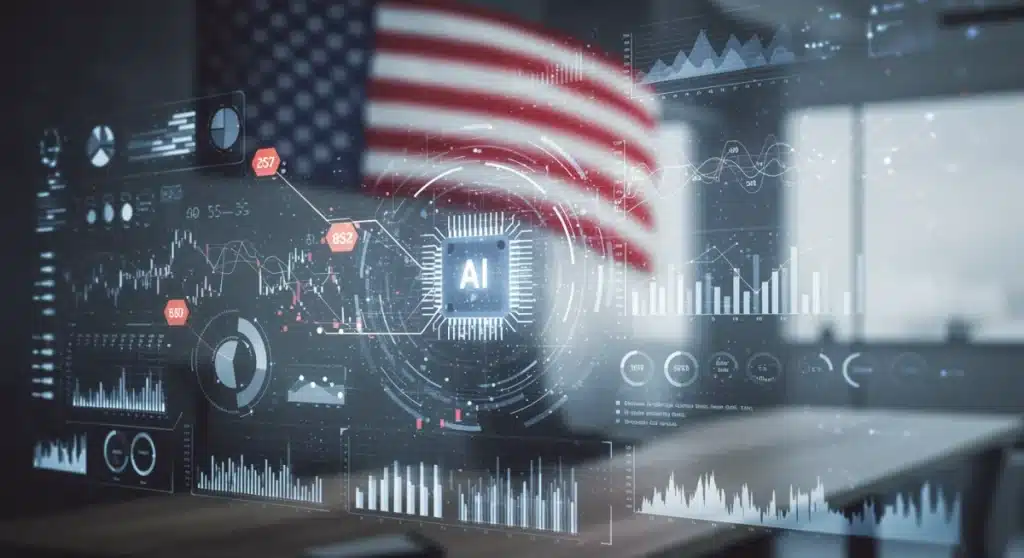AI Cost-Cutting: US Enterprises Slash Expenses by 20%

US enterprises can achieve substantial operational cost reductions, targeting a 20% decrease within 12 months, by strategically implementing AI solutions across various business functions, from automation to predictive analytics.
In today’s dynamic economic landscape, US enterprises are constantly seeking innovative strategies to enhance profitability and maintain a competitive edge. The imperative to reduce operational expenses without compromising quality or growth has never been more critical. This article explores how AI cost reduction strategies offer practical solutions for US businesses aiming to slash operational costs by a significant 20% within the next 12 months, transforming challenges into opportunities for unprecedented efficiency.
Leveraging AI for Enhanced Operational Efficiency
Artificial Intelligence (AI) is no longer a futuristic concept but a tangible tool revolutionizing business operations. By automating repetitive tasks, optimizing resource allocation, and providing predictive insights, AI stands as a cornerstone for significant cost savings across various sectors. The integration of AI allows businesses to streamline workflows, reduce human error, and make data-driven decisions that directly impact their bottom line.
The journey towards a 20% cost reduction begins with a thorough assessment of current operational expenditures and identifying areas ripe for AI intervention. This often involves processes that are manual, data-intensive, or prone to inefficiencies. AI’s ability to process vast amounts of data quickly and accurately makes it an ideal candidate for such optimization efforts.
Automating Repetitive Tasks with RPA
Robotic Process Automation (RPA), powered by AI, is a prime example of how enterprises can achieve immediate cost savings. RPA bots can mimic human actions to perform high-volume, repeatable tasks, freeing up human employees for more strategic work.
- Processing invoices and purchase orders.
- Managing customer service inquiries with chatbots.
- Automating data entry and migration.
- Reconciling financial statements.
By deploying RPA, businesses can significantly reduce labor costs associated with these tasks, improve accuracy, and accelerate processing times. This not only leads to direct cost savings but also enhances overall operational agility.
Optimizing Supply Chain and Logistics
The supply chain is often a major cost center for enterprises. AI can analyze vast datasets from logistics, inventory, and demand forecasts to identify inefficiencies and suggest optimal solutions. This leads to reduced waste, improved inventory management, and lower transportation costs.
AI algorithms can predict demand fluctuations with greater accuracy, allowing companies to adjust inventory levels proactively and avoid overstocking or stockouts. Furthermore, AI-powered route optimization can minimize fuel consumption and delivery times, directly contributing to cost reductions in logistics. The predictive capabilities extend to identifying potential disruptions before they occur, enabling proactive measures that mitigate costly delays.
In conclusion, AI’s role in enhancing operational efficiency is multifaceted, offering solutions from automating mundane tasks to optimizing complex supply chain networks. These applications directly contribute to substantial cost reductions, paving the way for enterprises to achieve their 20% savings target.
AI-Powered Predictive Analytics for Financial Forecasting
Predictive analytics, a core component of AI, empowers businesses to forecast future financial trends and potential risks with remarkable accuracy. This capability is invaluable for managing budgets, identifying potential cash flow issues, and making informed investment decisions. By analyzing historical data and external economic indicators, AI models can provide insights that traditional methods often miss, leading to more robust financial planning and significant cost avoidance.
The precision offered by AI in financial forecasting allows enterprises to allocate resources more efficiently, minimizing unnecessary expenditures and maximizing returns on investment. This proactive approach to financial management is crucial for maintaining fiscal health and achieving aggressive cost-reduction goals.
Enhanced Budgeting and Resource Allocation
AI can analyze past spending patterns and predict future needs, helping businesses create more accurate and dynamic budgets. This prevents overspending in certain areas and ensures that critical resources are allocated where they are most needed.
- Identifying redundant expenses.
- Forecasting project costs and risks.
- Optimizing capital expenditure planning.
- Predicting revenue streams with higher certainty.
Improved budgeting translates directly into cost savings by eliminating waste and ensuring that every dollar spent contributes effectively to business objectives. The ability to forecast with greater accuracy also reduces the likelihood of costly financial surprises.
Fraud Detection and Risk Mitigation
Financial fraud can lead to significant losses for enterprises. AI-powered systems can detect anomalous patterns in transactions and behavior that might indicate fraudulent activity, often in real-time. This proactive detection helps prevent financial losses before they escalate.
Beyond fraud, AI aids in identifying various financial risks, such as credit defaults or market volatility, allowing businesses to implement mitigation strategies promptly. By minimizing financial risks, enterprises protect their assets and avoid potentially massive costs associated with unforeseen financial challenges. This protective layer is a crucial aspect of achieving long-term cost stability and growth.
In essence, AI-powered predictive analytics provides a sophisticated framework for financial forecasting, enabling enterprises to manage their finances with greater foresight and precision. This leads to more effective budgeting, reduced financial risks, and ultimately, substantial cost savings.
Streamlining Customer Service with AI and Chatbots
Customer service departments are often significant cost centers, especially for large enterprises with high inquiry volumes. AI-driven solutions, particularly chatbots and virtual assistants, offer a powerful way to streamline these operations, reduce reliance on human agents for routine tasks, and enhance customer satisfaction simultaneously. This dual benefit makes AI in customer service a compelling strategy for cost reduction.
By deploying AI, businesses can ensure 24/7 availability for customer support, handling common queries instantly and efficiently. This not only lowers operational costs but also improves the customer experience, fostering loyalty and reducing churn, which are indirect but substantial cost savings.
Automated Customer Support with Chatbots
Chatbots can manage a vast array of customer interactions, from answering frequently asked questions to guiding users through troubleshooting steps. This significantly reduces the workload on human agents, allowing them to focus on more complex issues that require human empathy and problem-solving skills.
- Handling routine inquiries and FAQs.
- Providing instant support around the clock.
- Guiding customers through product information.
- Collecting customer feedback efficiently.
The implementation of chatbots leads to a direct reduction in staffing costs for customer service and can drastically cut down call center expenses. Furthermore, the speed and consistency of chatbot responses often lead to higher customer satisfaction rates.
Personalized Customer Experiences at Scale
AI can analyze customer data to provide personalized recommendations and support, anticipating needs before they are explicitly stated. This level of personalization, previously resource-intensive, can now be scaled efficiently using AI.
While often seen as a revenue-generating tool, personalized experiences also contribute to cost reduction by decreasing the likelihood of customer dissatisfaction and churn. A satisfied customer is less likely to require extensive support, reducing future service costs. Moreover, AI can identify patterns in customer complaints, allowing businesses to address root causes and prevent widespread issues, further saving on future support efforts.
Ultimately, AI and chatbots transform customer service from a cost center into an efficient, customer-centric operation. This leads to significant savings in labor and infrastructure while improving the overall customer journey, aligning perfectly with a 20% cost reduction goal.
AI in Human Resources: Reducing Recruitment and Training Costs
The Human Resources (HR) department often incurs substantial costs related to recruitment, onboarding, and training. AI offers innovative solutions to optimize these processes, making them more efficient, less time-consuming, and ultimately, more cost-effective. By leveraging AI, enterprises can streamline talent acquisition, improve employee retention, and reduce the overall expenditure associated with managing their workforce.
AI’s ability to analyze vast amounts of data meticulously makes it an invaluable tool for identifying the best candidates, personalizing training programs, and predicting potential employee turnover. These capabilities directly contribute to lowering HR operational costs while simultaneously enhancing workforce quality.
Optimizing Recruitment and Onboarding
AI tools can automate various stages of the recruitment process, from resume screening to initial candidate assessments. This reduces the time and effort human recruiters spend on administrative tasks, allowing them to focus on strategic talent engagement.
- Automated resume screening and shortlisting.
- AI-powered interview scheduling.
- Predictive analytics for candidate success.
- Streamlined onboarding processes.
By improving the efficiency and accuracy of recruitment, businesses can reduce the cost-per-hire and decrease the likelihood of bad hires, which are notoriously expensive. A more efficient onboarding process also means new employees become productive faster, further contributing to cost savings.
Personalized Training and Development
AI can analyze an employee’s skills, performance data, and career aspirations to recommend personalized training modules. This ensures that training budgets are spent on programs that are most relevant and beneficial to individual employees and the organization.

Personalized training not only increases its effectiveness but also reduces the waste associated with generic, one-size-fits-all programs. Furthermore, by investing in relevant development, AI helps improve employee satisfaction and retention, lowering the significant costs associated with employee turnover. This strategic application of AI in HR directly supports the enterprise’s cost-cutting objectives.
In conclusion, AI in HR provides powerful tools to significantly reduce costs associated with recruitment, onboarding, and employee development. By making these processes more efficient and personalized, enterprises can achieve substantial savings while building a more skilled and satisfied workforce.
AI for Energy Management and Infrastructure Optimization
Energy consumption and infrastructure maintenance represent significant operational costs for many US enterprises, particularly those with large physical footprints or extensive IT infrastructure. AI offers advanced solutions for monitoring, analyzing, and optimizing energy usage and maintaining critical systems, leading to substantial cost reductions and improved sustainability.
By deploying AI-powered systems, businesses can gain granular insights into their energy consumption patterns, identify inefficiencies, and automate adjustments to reduce waste. This proactive approach to resource management is vital for achieving aggressive cost-cutting targets within the next 12 months.
Smart Energy Consumption Monitoring
AI systems can continuously monitor energy usage across various departments, facilities, or data centers. By analyzing this data in real-time, AI can detect anomalies, predict peak consumption times, and recommend or automatically implement adjustments to reduce energy waste.
- Optimizing HVAC systems based on occupancy and weather.
- Automating lighting in commercial buildings.
- Predicting equipment failures to prevent energy spikes.
- Identifying energy-inefficient devices.
These smart energy management solutions directly translate into lower utility bills and a reduced carbon footprint, providing both financial and environmental benefits. The ability to fine-tune energy usage dynamically is a powerful tool for cost control.
Predictive Maintenance for Infrastructure
Equipment breakdowns can lead to costly downtime, emergency repairs, and lost productivity. AI-powered predictive maintenance analyzes data from sensors on machinery and infrastructure to anticipate potential failures before they occur.
By scheduling maintenance proactively, enterprises can avoid costly emergency repairs, extend the lifespan of their assets, and minimize operational disruptions. This approach significantly reduces maintenance costs and prevents revenue losses associated with unexpected outages. The strategic use of AI in infrastructure management ensures continuous operation and minimizes unforeseen expenditures, contributing substantially to the 20% cost reduction goal.
Ultimately, AI’s application in energy management and infrastructure optimization provides a robust framework for reducing some of the most persistent operational costs. By making systems smarter and more predictive, enterprises can achieve significant savings and enhance their overall operational resilience.
Data-Driven Decision Making and Waste Reduction
At its core, AI thrives on data, transforming raw information into actionable insights. This capability is paramount for identifying hidden inefficiencies and opportunities for waste reduction across an enterprise. By moving beyond intuition and relying on data-driven decision-making, US businesses can systematically dismantle areas of unnecessary expenditure, contributing significantly to their 20% cost reduction target.
AI’s analytical prowess allows for a comprehensive understanding of operational bottlenecks, resource misallocation, and redundant processes. This holistic view enables businesses to implement targeted interventions that yield maximum cost savings.
Identifying and Eliminating Inefficiencies
AI algorithms can sift through vast datasets related to production, inventory, and operational workflows to pinpoint inefficiencies that might be invisible to human analysis. This includes identifying overproduction, underutilized resources, or bottlenecks that slow down processes.
- Analyzing production line performance for bottlenecks.
- Optimizing inventory levels to reduce holding costs.
- Identifying redundant software subscriptions.
- Streamlining administrative processes.
By systematically identifying and eliminating these inefficiencies, enterprises can achieve significant savings in materials, labor, and time. This granular approach to cost reduction ensures that resources are utilized optimally across the entire organization.
Optimizing Procurement and Vendor Management
Procurement is another area where AI can drive substantial cost savings. AI can analyze purchasing data, vendor performance, and market trends to optimize sourcing strategies, negotiate better deals, and identify potential savings.
AI can also monitor vendor compliance and performance, ensuring that businesses are getting the best value for their money and avoiding costly disputes or delays. By making procurement more strategic and data-informed, enterprises can significantly reduce their acquisition costs for goods and services. This optimization extends to identifying opportunities for bulk purchasing or negotiating favorable terms based on projected needs, further cementing the path to a 20% operational expense reduction.
In summary, data-driven decision-making powered by AI is a critical enabler for identifying and eliminating waste across all business functions. From optimizing production to streamlining procurement, AI provides the insights needed to achieve significant and sustainable cost reductions.
Implementing AI: A Strategic Roadmap for Cost Reduction
Achieving a 20% reduction in operational expenses within 12 months through AI requires more than just adopting new technologies; it demands a strategic roadmap and a commitment to change management. Enterprises must approach AI implementation with a clear vision, phased execution, and continuous evaluation to realize its full cost-saving potential. This journey involves not only technological integration but also a cultural shift towards data-driven innovation.
A well-defined strategy ensures that AI initiatives are aligned with business objectives, resources are allocated effectively, and potential challenges are addressed proactively. Without a cohesive roadmap, AI projects can easily become costly endeavors with limited returns.
Phased Implementation and Pilot Programs
Instead of a sweeping overhaul, enterprises should consider a phased approach to AI implementation, starting with pilot programs in areas identified for high cost-saving potential. This allows for testing, learning, and refining AI solutions before a broader rollout.
- Starting with low-risk, high-impact areas.
- Collecting data and measuring ROI from pilot projects.
- Iterating and refining AI models based on performance.
- Scaling successful solutions across the organization.
Pilot programs minimize risk and provide valuable insights into the practicalities of AI integration, ensuring that subsequent deployments are more effective and cost-efficient. This iterative process is crucial for maximizing the return on AI investments.
Measuring ROI and Continuous Optimization
To ensure that AI initiatives are truly contributing to cost reduction, enterprises must establish clear metrics for measuring Return on Investment (ROI). This involves tracking key performance indicators (KPIs) related to operational expenses, efficiency gains, and productivity improvements.
The journey with AI is not a one-time project but an ongoing process of continuous optimization. As data accumulates and business needs evolve, AI models should be regularly refined and updated to maintain their effectiveness and identify new opportunities for savings. This commitment to continuous improvement ensures that the 20% cost reduction is not just a target but a sustainable outcome. Regular evaluation helps in identifying new areas where AI can be applied for further efficiency gains, making the enterprise more resilient and cost-effective in the long run.
In conclusion, a strategic roadmap encompassing phased implementation, rigorous ROI measurement, and continuous optimization is essential for harnessing AI’s full potential in cost reduction. By following this approach, US enterprises can confidently navigate their path to a 20% reduction in operational expenses.
| Key Area | AI Cost Reduction Strategy |
|---|---|
| Operations | Automate repetitive tasks and optimize supply chains with RPA and predictive analytics. |
| Finance | Improve forecasting, budgeting, and fraud detection using AI-powered analytics. |
| Customer Service | Deploy chatbots and virtual assistants to handle routine inquiries, reducing staff load. |
| HR & Infrastructure | Optimize recruitment, personalized training, energy management, and predictive maintenance. |
Frequently Asked Questions About AI Cost Reduction
The primary benefit is the ability to automate repetitive tasks, optimize complex processes, and provide data-driven insights. This leads to significant savings in labor, operational inefficiencies, and resource allocation, helping enterprises achieve ambitious cost-cutting goals.
While some benefits, like RPA, can yield rapid returns, achieving a 20% operational expense reduction typically requires a strategic, phased approach over 6 to 12 months. Early pilot programs can demonstrate initial savings within a few weeks or months.
Key challenges include data quality and availability, the need for specialized AI talent, initial investment costs, and resistance to change within the organization. Overcoming these requires careful planning and strong leadership.
Yes, AI’s versatility allows it to identify and address inefficiencies across virtually all business sectors, from manufacturing and logistics to finance, HR, and customer service. The specific applications may vary, but the underlying principles of data optimization remain consistent.
Data is the fuel for AI. High-quality, relevant data is crucial for training AI models to accurately identify patterns, make predictions, and drive effective cost-saving strategies. Without robust data, AI’s potential is significantly limited.
Conclusion
The pursuit of cost efficiency is a perpetual challenge for US enterprises, yet the advent of AI presents an unprecedented opportunity to address this head-on. By strategically integrating AI across various operational facets—from automating routine tasks and optimizing supply chains to enhancing financial forecasting and streamlining customer service—businesses can realistically aim for and achieve a 20% reduction in operational expenses within the next 12 months. The key lies in a well-articulated strategy, a phased implementation approach, and a commitment to continuous learning and adaptation. Embracing AI is not merely about cutting costs; it’s about fostering a more agile, resilient, and future-ready enterprise that can thrive in an increasingly competitive global market. The time to leverage AI for transformative cost savings is now.





